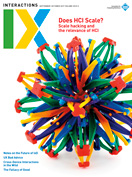Authors:
Gerrit van der Veer
SIGCHI cares about HCI education. (See sigchi.org/education for information on our previous activities.) SIGCHI's umbrella group, ACM, is the world's leading organization in developing and publishing curriculum recommendations for undergraduate and graduate programs in computer science education. The ACM or ACM/ IEEE curriculum recommendations are in fact the handbooks, and often law, for higher-education institutes and national educational authorities around the world (e.g., in North America, Europe, China, India, and several other Asian and Middle Eastern countries).
Consequently, SIGCHI collaborates. For the 2014 Curriculum Guidelines for Undergraduate Degree Programs in Software Engineering (a joint project of ACM and IEEE), we had considerable input from others, especially in the sections on requirements analysis and specs, software design, and professional practice (www.acm.org/binaries/content/assets/education/se2014.pdf).
For the 2017 Information Technology (IT) Curricula, we at SIGCHI were official partners in the task group from its beginnings in 2014. Early in this project, we connected worldwide with educators in the domain and practitioners who were responsible for hiring, requesting their input and asking them to submit surveys after several versions of the guidelines were drafted. At the beginning of this year, we had one final round with a small set of industry and government professionals from North America, Latin America, and Europe, as well as with a large and geographically diverse sample of academic educators from Africa, Asia, Australia, Europe, and North and South America.
As of this writing, the final document is about to be published. After discussion across our worldwide, multilingual audience, we decided that the label for our own domain (HCI) within the IT curriculum would be User Experience Design. It is one of five "essential only" parts of the curriculum, which means the content is supposed to be compulsory. Compare it with cloud computing, which is an optional subdomain totally dependent on local choices. In total, there are 10 essential or partly essential subdomains, accounting for 40 percent of the compulsory curriculum. Among optional subdomains is the Internet of Things, which includes additional HCI-related topics such as human-machine communication.
The scope of the compulsory domain UX Design is described in the document as follows:
- Understanding of advocacy for the user in the development of IT applications and systems
- Development of a mindset that recognizes the importance of users, context of use, and organizational contexts
- Employment of user-centered methodologies in the design, development, evaluation, and deployment of IT applications and systems
- Application of evaluation criteria, benchmarks, and standards
- User and task analysis, human factors, ergonomics, accessibility standards, experience design, and cognitive psychology.
It includes these competencies:
- Design an interactive application, applying a user-centered design cycle and related tools and techniques (e.g., prototyping), aiming at usability and relevant user experience within a corporate environment. (Design tools and techniques)
- For a case of user-centered design, analyze and evaluate the context of use, stakeholder needs, state-of-the-art interaction opportunities, and envisioned solutions, considering user attitude and applying relevant tools and techniques (e.g., heuristic evaluation), aiming at universal access and inclusiveness, and showing a responsive design attitude, considering assistive technologies and culture-sensitive design. (Stakeholder needs)
- For evaluation of user-centered design, articulate evaluation criteria and compliance to relevant standards (Benchmarks and standards)
- In design and analysis, apply knowledge from related disciplines including human information processing, anthropology and ethnography, and ergonomics/human factors. (Integrative design)
- Apply experience design for a service domain related to several disciplines, focusing on multiple stakeholders and collaborating in an interdisciplinary design team. (Application design)
And it features the following subdomains: perspectives and impact, human factors in design, effective interfaces, application domain aspects, affective user experiences, human-centered evaluation, assistive technologies and accessibility, and user advocacy.
An interesting part of the report is a set of detailed descriptions of example curricula for different parts of the world.
An interesting part of the report is a set of detailed descriptions of example curricula for different parts of the world (North and Latin America, Europe, Middle East and Saudi Arabia, China, Europe, Australia and New Zealand), as well as some IT curricula for non-traditional contexts.
SIGCHI continues to be involved in setting educational guidelines. We are now participating in the development of Computing Curricula 2020, an overview report aiming at a set of living computing curricula.
Gerrit C. van der Veer, Past President, ACM SIGCHI [email protected]
Copyright held by author
The Digital Library is published by the Association for Computing Machinery. Copyright © 2017 ACM, Inc.







Post Comment
No Comments Found